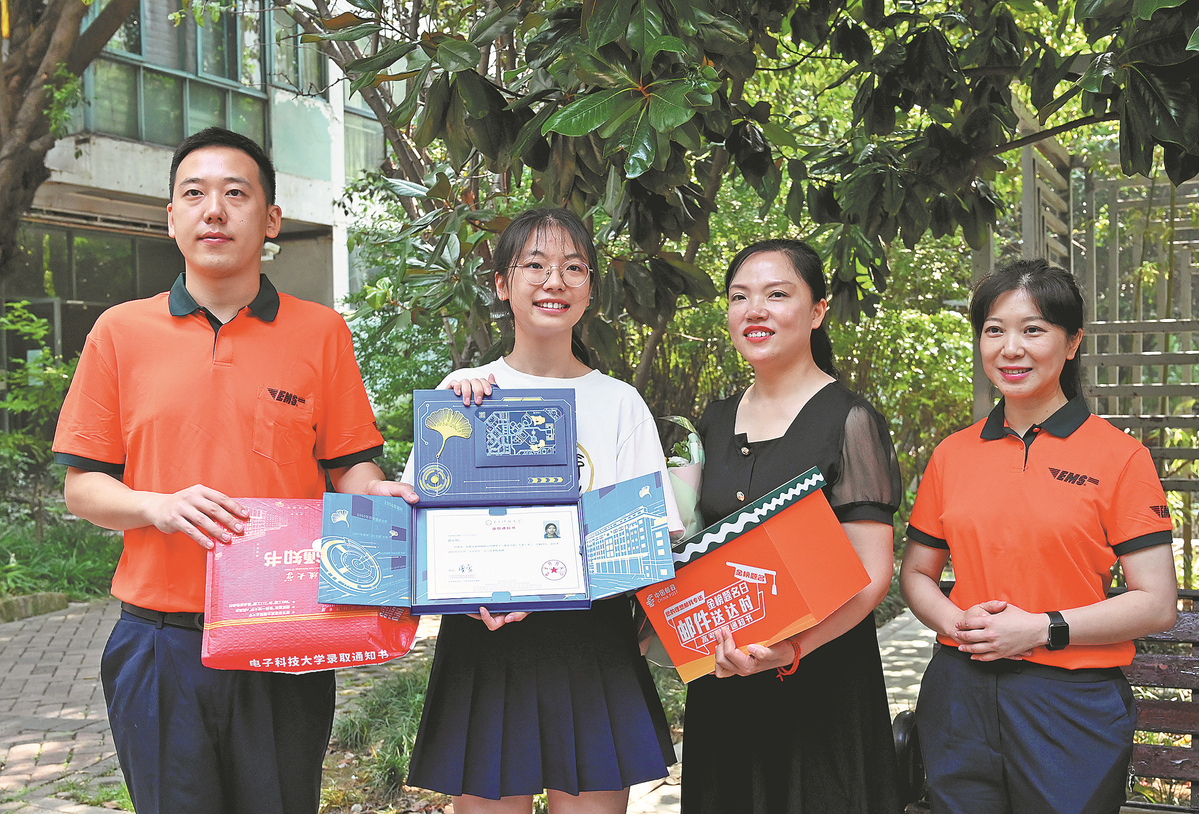即可将网页分享至朋友圈
Around this time of year, colleges start thinking about the designs of their college admissions letters to draw more attention from outstanding senior high school graduates.

Zhao Xinyi displays her admission letter to the University of Electronic Science and Technology of China in Chengdu, Sichuan province, on Saturday. It is the province's first admission letter to be sent out this year. (Photo: China News Service)
While some technological universities simply boast of their achievements, others go the extra mile to woo potential students.
The University of Science and Technology Beijing's admissions letter, for example, is made from ultra thin steel called"5G steel".
The sturdy steel is generally used in 5G base station signal receivers, signal transmission filters and integrated circuit boards.
As thin as 0.07 millimeters — roughly equivalent to a cicada's wings — 5G steel was codeveloped by USTB and Shougang Group, according to the university's account on Weibo, China's Twitter-like social media platform.
Founded in 1952, the university, formerly known as the Beijing Institute of Iron and Steel Technology, is the first institution of higher education to focus on the iron and steel industry in China.
The admissions letter represents the university's hopes that its students' determination to succeed, and their willingness to contribute to China's development, will be as strong as steel, according to its post on Weibo.
Meanwhile, the admissions letter designed by Nankai University in Tianjin has also created a buzz on social media.
It contains two lotus seeds from Huaian in Jiangsu province, the hometown of the first premier of China, Zhou Enlai, an alumnus of the university.
In China, the lotus is admired for its ability to emerge from murky waters and bloom into a beautiful flower, representing the journey of attaining enlightenment and rising above challenges in life. It is also seen as a symbol of beauty, grace and resilience.
The school hopes that students will plant one of the seeds in their hometowns, to serve as a reminder to never forget where they come from and to stay true to their original aspirations, and plant the other at the university when they arrive, so that it will be alongside them during their personal growth and development, according to a Nankai University official.
Elsewhere, "the Big Dipper letter", which features seven soybeans arranged in the form of the notable constellation in the admissions letters designed by the University of Chinese Academy of Sciences, has also impressed many who have received it. The soybean species, called Dongsheng 118, was developed by a research team at the Northeast Institute of Geography and Agroecology, part of the Chinese Academy of Sciences, in saline fields in Jilin province.
Starting in 2017, the team spent nearly seven years overcoming challenges to successfully cultivate the soybean. In October last year, they reached a yield of 2.25 metric tons per hectare, marking a significant step in China's efforts to reduce its reliance on soybean imports, according to UCAS.
In the admissions letter, Zhou Qi, academician of CAS and president of UCAS, said that he hopes the letter's seeds represent a passion for science that will grow inside students' hearts, and encourage them to make more contributions to the country and the well-being of its people.
The letter also includes a book that features applications of 100 scientists to join the Communist Party of China and words of encouragement from 12 academicians of the Chinese Academy of Sciences and the Chinese Academy of Engineering.
The admissions letter from Sun Yat-sen University in Guangdong province is also eye-catching.
It contains a brick of Pu'er tea from Fengqing county in Yunnan province. Fengqing is the designated assistance county for Sun Yat-sen University, which has pledged to offer the county help in various aspects.
Adding tea into an admissions letter is seen as a way to help market agricultural products from Yunnan. The brick weighs 99 grams, signaling 99 years since the tea was discovered. It is also meant to serve as a kind of metaphorical expression to call on students to "add bricks" to help develop the country.
Beihang University in Beijing has also offered a surprise with its admissions letter.
It contains a model of Beijing 1, the first light passenger aircraft in China, which was developed by the university. With joint efforts made by more than 1,000 students and teachers, the aircraft successfully took off in 1958, marking a glorious achievement for Beihang.
The admissions letter from the Harbin Institute of Technology in Heilongjiang province contains a red bookmark coated in a special paint used by Tianwen 1, China's first mission to Mars.
The coating has been applied to the Chinese flag displayed on Tianwen 1's Martian orbiter and on the images of the Beijing Winter Olympic and Paralympic mascots — Bing Dwen Dwen and Shuey Rhon Rhon — which are featured on its landing platform.
报道链接:Admissions letters aim to draw more attention (pdnews.cn)
编辑: / 审核: / 发布:


